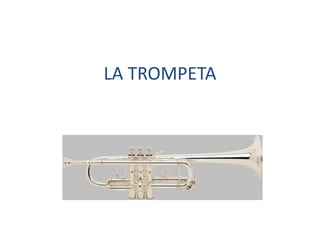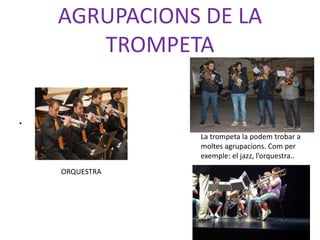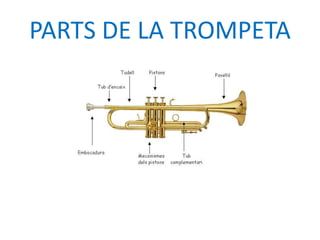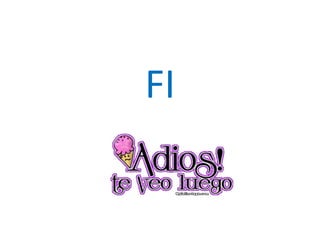La trompeta
Download as pptx, pdf0 likes3,128 views
Treball de recerca sobre la trompeta. Curs 4tA. escola Roser Capdevila de PolinyĂ . Curs 2014-15.
1 of 7
Download to read offline







Ad
Recommended
La trompeta
La trompetaGonzalo
Ěý
Treball de recerca sobre la trompeta. Grup de 4tB, escola Roser Capdevila de PolinyĂ . Curs 2014-15.La flauta travesseraGonzalo
Ěý
La flauta travesera es un instrumento de viento de la familia de las flautas. Está compuesta por una embocadura, un cuerpo cilĂndrico con agujeros y una boquilla. La flauta travesera se usa en orquestas, grupos de jazz, cámara, rock y otros grupos musicales. El documento tambiĂ©n incluye un video de una niña tocando la flauta travesera.La flauta travessera
La flauta travesseraGonzalo
Ěý
Treball de recerca sobre la flauta travessera de 4tA. escola Roser Capdevila de PolinyĂ . Curs 2014-15.The History of the Trumpet
The History of the TrumpetChristina Colley
Ěý
The document traces the history of the trumpet from ancient Rome until today. It discusses trumpets prior to the fall of Rome, Renaissance trumpets from 1400-1600, Baroque trumpets from 1600-1750, Classical trumpets from 1750-1825, the invention of the valve in 1815 which allowed for chromatic playing, and the modern trumpet from 1839 to present day. The document provides sources for further information on different eras of trumpet history.Trumpet Techniques 2016
Trumpet Techniques 2016Randall Bennett
Ěý
This document is an introduction to the method book for prospective members of the Pioneer Drum & Bugle Corps brass section. It outlines the philosophy and approach to teaching used by the brass staff. Winter camp dates will be announced soon and attendance is required to be considered for membership. The method book covers topics like posture, breathing, tone production, articulation and more. It provides exercises to develop skills in each area and familiarize students with the staff's pedagogical approach. Prospective members are encouraged to review the material as preparation for auditioning and the upcoming season with Pioneer Drum & Bugle Corps.Animal Abuse Once Again Caught on Film at Tyson Chicken
Animal Abuse Once Again Caught on Film at Tyson ChickenMaral Cavner
Ěý
An investigator documented severe animal abuse at a Tyson chicken slaughter plant over 21 days, revealing a lack of concern for animal and worker welfare. The high-speed requirement of hanging 35 chickens per minute led to inhumane treatment of the birds and hazardous conditions for workers. Maral Cavner, a law student and animal rights advocate, supports the efforts of the Animal Legal Defense Fund to combat such cruelty.Trumpets
TrumpetsChadron State College
Ěý
The trumpet is a brass instrument that is made of brass, specifically a mix of copper and zinc. It is part of the brass family and can play the highest notes of brass instruments. Trumpets come in different keys like B-flat, C, E-flat, and piccolo and have three valves used to play different notes. Trumpets are used in many styles of music like jazz, classical, and rock.Trumpet - Major Scale
Trumpet - Major Scalepgately
Ěý
The document provides instructions for playing a C major scale on the trumpet. It discusses the history of the trumpet, famous trumpet players, how to buzz one's lips to produce sound, and the specific fingerings for each note in the C major scale. A video is included of someone demonstrating the C major scale on trumpet. The summary reminds trumpet players to maintain good posture, have strong air support, and keep their lip corners tight for accurate intonation when playing higher notes.The Basic Parts of the Trumpet
The Basic Parts of the TrumpetMaral Cavner
Ěý
This document summarizes the basic parts of the trumpet, including the bell, mouthpiece, and tuning slide. The bell creates the trumpet's tone and comes in different diameters and coatings. The mouthpiece is made of metal and consists of a cup and tube to produce sound. The tuning slide is the trumpet's largest slide and alters the tone by changing the amount of air entering the instrument depending on where it is positioned.The History Of The Trumpet
The History Of The Trumpetlazydudexoxo
Ěý
The earliest trumpets date back to 2000 BC and were found in Egypt, Scandinavia, and China. The C trumpet is commonly used in American orchestras as it produces a brighter sound than the B-flat trumpet. Modern trumpets use three piston valves to change the tubing length and lower the pitch, while the mouthpiece affects the timbre, playability, and comfort. Legendary jazz musician Louis Armstrong was one of the most famous trumpet players known for his improvisational skills.Trompetajpalop
Ěý
La trompeta es un instrumento de metal que produce sonido a través de la vibración de los labios en la boquilla. Se originó en la antigüedad entre los egipcios y mesopotamios, quienes la usaban en rituales y paradas militares. Es comúnmente afinada en si bemol aunque también existe en otras afinaciones como fa y do.Let the Trumpet Sound
Let the Trumpet SoundJohan Koren
Ěý
The document discusses the importance of 21st-century literacy skills, particularly in the context of online comprehension and the evolving technological landscape. It highlights the need for educators to prepare students for diverse forms of media and information, emphasizing the evaluation of online resources for credibility and accuracy. Additionally, it outlines a guided inquiry approach for effective information-seeking strategies in educational settings.Digitación de las notas en la flauta dulceMónica Gallego González
Ěý
El documento proporciona una guĂa sobre las posiciones de las notas en la flauta dulce, incluyendo la colocaciĂłn de las manos y la utilizaciĂłn del portavoz para producir sonidos agudos. Se clasifica la dificultad de los sonidos de menor a mayor, comenzando con los más fáciles. Cada sonido está asociado a un color especĂfico en el Ăndice presentado.Viento metalommasi
Ěý
Los instrumentos de viento de metal, como la trompa, la trompeta y el trombĂłn, producen sonido al hacer pasar aire a travĂ©s de un tubo de metal. Se dividen en de tubo cĂłnico como la trompa, y de tubo cilĂndrico como la trompeta. Cada instrumento tiene un papel distinto en la orquesta y ha sido usado en obras importantes de compositores como Mozart, Beethoven y Wagner.Aprender a tocar flautaAdriana Peña
Ěý
En una breve presentación de Power Point, un niño que curse tercer año de primaria podra aprender facilmente a tocar flauta dulce.Presentación trompetaangelstock12
Ěý
Este documento describe los accesorios y tipos de trompetas. Entre los accesorios más importantes se encuentran las sordinas (straight, cup, wah-wah y electrónica), boquillas y pies (de tres y cinco patas, atril de pie y atril de calle). Los tipos de trompetas incluyen la trompeta en do o si bemol, de varas, piccolo, baja y de bolsillo.Los instrumentos de viento metalUniversidad Popular Carmen de Michelena
Ěý
La secciĂłn de viento-metal de la orquesta incluye instrumentos como trompas, trompetas, trombones y tubas, caracterizados por su construcciĂłn en metal y la producciĂłn de sonidos potentes. Estos instrumentos han evolucionado a lo largo del tiempo, incorporando mecanismos como válvulas y pistones que permiten una mayor flexibilidad tonal. Cada instrumento tiene caracterĂsticas especĂficas, como la trompa cĂłnica, la trompeta cilĂndrica y la tuba, que desempeñan roles distintos en la orquesta.Elementos del lenguaje musicalCEIP VIRGEN DE LA CONSOLACIĂ“N Y CEIP NUESTRA SEĂ‘ORA DE LA ASUCION
Ěý
La mĂşsica es el arte de combinar sonidos y silencios para crear una experiencia estĂ©tica, que se compone de elementos como la altura, duraciĂłn, intensidad y timbre. El documento tambiĂ©n detalla aspectos tĂ©cnicos, como el pentagrama, las escalas, las melodĂas, las alteraciones musicales y diversas formas musicales. Además, aborda la clasificaciĂłn de las voces humanas, los instrumentos, y la relaciĂłn entre la mĂşsica y la danza.Libro flauta primaria 3Âş, 4Âş, 5Âş y 6ÂşCEIP VIRGEN DE LA CONSOLACIĂ“N Y CEIP NUESTRA SEĂ‘ORA DE LA ASUCION
Ěý
Partituras para flauta en la etapa de primaria. Busca tu partitura y a tocar. Los tutoriales los puedes seguir en el siguiente blog: http://musicaferiaylaparra.blogspot.com.es/ Atrapa un deu vertebrats i invertebrats
Atrapa un deu vertebrats i invertebratsFedacStAndreuCSuperior
Ěý
Concurs sobre vertebrats i invertebratsInstrumentos De Viento MetalAnaiiS
Ěý
Los instrumentos de viento metal principales son la trompeta, el trombĂłn, la trompa y la tuba. Producen sonido a travĂ©s de la vibraciĂłn de los labios en la boquilla que hace pasar aire por el tubo metálico. Pueden modificar la longitud del tubo mediante pistones, válvulas o una vara deslizante para producir diferentes notas. Cada instrumento tiene caracterĂsticas Ăşnicas de timbre, extensiĂłn y tĂ©cnica.Places assigandes curs 25-26 escola Roser Capdevila
Places assigandes curs 25-26 escola Roser CapdevilaEscolaRoserCapdevila18
Ěý
El llistat de places assignades per la matrĂcula del curs 25-26, de l'escola Roser Capdevila de Sant Joan DespĂINFORME_LLISTA_ESPERA_OME_LLISTA_ESPERAescolaernestlluch.pdf
INFORME_LLISTA_ESPERA_OME_LLISTA_ESPERAescolaernestlluch.pdfErnest Lluch
Ěý
LLISTA D'ESPERA
PREINSCRIPCIĂ“ 25/2620250616+¸é±đ±ąľ±˛őłŮ˛ą+ł˘˛ą+łŐľ±˛Ô˛â´ÇłŮ˛ą+-+·ˇ˛őł¦´Ç±ô˛ą+ł§˛ą˛ÔłŮ+łŐľ±ł¦±đ˛Ôç+»ĺ±đ+˛Ń´Ç±ô±ô±đłŮ+»ĺ±đ±ô+łŐ˛ą±ô±ôè˛ő+-+±đ»ĺľ±ł¦ľ±...
20250616+¸é±đ±ąľ±˛őłŮ˛ą+ł˘˛ą+łŐľ±˛Ô˛â´ÇłŮ˛ą+-+·ˇ˛őł¦´Ç±ô˛ą+ł§˛ą˛ÔłŮ+łŐľ±ł¦±đ˛Ôç+»ĺ±đ+˛Ń´Ç±ô±ô±đłŮ+»ĺ±đ±ô+łŐ˛ą±ô±ôè˛ő+-+±đ»ĺľ±ł¦ľ±...montsefarell1
Ěý
Escola Sant Vicenç de Mollet del VallèsInforme Llista d'espera Escola Roser Capdevila
Informe Llista d'espera Escola Roser CapdevilaEscolaRoserCapdevila18
Ěý
PublicaciĂł de la llista d'espera per la matrĂcula del curs 25-26 de l'escola Roser Capdevila de Sant Joan DespĂ.INFORME_ASSIGNADES_INFORME_ASSIGNADESescolaernestlluch.pdf
INFORME_ASSIGNADES_INFORME_ASSIGNADESescolaernestlluch.pdfErnest Lluch
Ěý
ALUMNES ASSIGNATS
PREINSCRIPCIĂ“ 25/26More Related Content
Viewers also liked (15)
Trumpet - Major Scale
Trumpet - Major Scalepgately
Ěý
The document provides instructions for playing a C major scale on the trumpet. It discusses the history of the trumpet, famous trumpet players, how to buzz one's lips to produce sound, and the specific fingerings for each note in the C major scale. A video is included of someone demonstrating the C major scale on trumpet. The summary reminds trumpet players to maintain good posture, have strong air support, and keep their lip corners tight for accurate intonation when playing higher notes.The Basic Parts of the Trumpet
The Basic Parts of the TrumpetMaral Cavner
Ěý
This document summarizes the basic parts of the trumpet, including the bell, mouthpiece, and tuning slide. The bell creates the trumpet's tone and comes in different diameters and coatings. The mouthpiece is made of metal and consists of a cup and tube to produce sound. The tuning slide is the trumpet's largest slide and alters the tone by changing the amount of air entering the instrument depending on where it is positioned.The History Of The Trumpet
The History Of The Trumpetlazydudexoxo
Ěý
The earliest trumpets date back to 2000 BC and were found in Egypt, Scandinavia, and China. The C trumpet is commonly used in American orchestras as it produces a brighter sound than the B-flat trumpet. Modern trumpets use three piston valves to change the tubing length and lower the pitch, while the mouthpiece affects the timbre, playability, and comfort. Legendary jazz musician Louis Armstrong was one of the most famous trumpet players known for his improvisational skills.Trompetajpalop
Ěý
La trompeta es un instrumento de metal que produce sonido a través de la vibración de los labios en la boquilla. Se originó en la antigüedad entre los egipcios y mesopotamios, quienes la usaban en rituales y paradas militares. Es comúnmente afinada en si bemol aunque también existe en otras afinaciones como fa y do.Let the Trumpet Sound
Let the Trumpet SoundJohan Koren
Ěý
The document discusses the importance of 21st-century literacy skills, particularly in the context of online comprehension and the evolving technological landscape. It highlights the need for educators to prepare students for diverse forms of media and information, emphasizing the evaluation of online resources for credibility and accuracy. Additionally, it outlines a guided inquiry approach for effective information-seeking strategies in educational settings.Digitación de las notas en la flauta dulceMónica Gallego González
Ěý
El documento proporciona una guĂa sobre las posiciones de las notas en la flauta dulce, incluyendo la colocaciĂłn de las manos y la utilizaciĂłn del portavoz para producir sonidos agudos. Se clasifica la dificultad de los sonidos de menor a mayor, comenzando con los más fáciles. Cada sonido está asociado a un color especĂfico en el Ăndice presentado.Viento metalommasi
Ěý
Los instrumentos de viento de metal, como la trompa, la trompeta y el trombĂłn, producen sonido al hacer pasar aire a travĂ©s de un tubo de metal. Se dividen en de tubo cĂłnico como la trompa, y de tubo cilĂndrico como la trompeta. Cada instrumento tiene un papel distinto en la orquesta y ha sido usado en obras importantes de compositores como Mozart, Beethoven y Wagner.Aprender a tocar flautaAdriana Peña
Ěý
En una breve presentación de Power Point, un niño que curse tercer año de primaria podra aprender facilmente a tocar flauta dulce.Presentación trompetaangelstock12
Ěý
Este documento describe los accesorios y tipos de trompetas. Entre los accesorios más importantes se encuentran las sordinas (straight, cup, wah-wah y electrónica), boquillas y pies (de tres y cinco patas, atril de pie y atril de calle). Los tipos de trompetas incluyen la trompeta en do o si bemol, de varas, piccolo, baja y de bolsillo.Los instrumentos de viento metalUniversidad Popular Carmen de Michelena
Ěý
La secciĂłn de viento-metal de la orquesta incluye instrumentos como trompas, trompetas, trombones y tubas, caracterizados por su construcciĂłn en metal y la producciĂłn de sonidos potentes. Estos instrumentos han evolucionado a lo largo del tiempo, incorporando mecanismos como válvulas y pistones que permiten una mayor flexibilidad tonal. Cada instrumento tiene caracterĂsticas especĂficas, como la trompa cĂłnica, la trompeta cilĂndrica y la tuba, que desempeñan roles distintos en la orquesta.Elementos del lenguaje musicalCEIP VIRGEN DE LA CONSOLACIĂ“N Y CEIP NUESTRA SEĂ‘ORA DE LA ASUCION
Ěý
La mĂşsica es el arte de combinar sonidos y silencios para crear una experiencia estĂ©tica, que se compone de elementos como la altura, duraciĂłn, intensidad y timbre. El documento tambiĂ©n detalla aspectos tĂ©cnicos, como el pentagrama, las escalas, las melodĂas, las alteraciones musicales y diversas formas musicales. Además, aborda la clasificaciĂłn de las voces humanas, los instrumentos, y la relaciĂłn entre la mĂşsica y la danza.Libro flauta primaria 3Âş, 4Âş, 5Âş y 6ÂşCEIP VIRGEN DE LA CONSOLACIĂ“N Y CEIP NUESTRA SEĂ‘ORA DE LA ASUCION
Ěý
Partituras para flauta en la etapa de primaria. Busca tu partitura y a tocar. Los tutoriales los puedes seguir en el siguiente blog: http://musicaferiaylaparra.blogspot.com.es/ Atrapa un deu vertebrats i invertebrats
Atrapa un deu vertebrats i invertebratsFedacStAndreuCSuperior
Ěý
Concurs sobre vertebrats i invertebratsInstrumentos De Viento MetalAnaiiS
Ěý
Los instrumentos de viento metal principales son la trompeta, el trombĂłn, la trompa y la tuba. Producen sonido a travĂ©s de la vibraciĂłn de los labios en la boquilla que hace pasar aire por el tubo metálico. Pueden modificar la longitud del tubo mediante pistones, válvulas o una vara deslizante para producir diferentes notas. Cada instrumento tiene caracterĂsticas Ăşnicas de timbre, extensiĂłn y tĂ©cnica.Libro flauta primaria 3Âş, 4Âş, 5Âş y 6ÂşCEIP VIRGEN DE LA CONSOLACIĂ“N Y CEIP NUESTRA SEĂ‘ORA DE LA ASUCION
Ěý
Recently uploaded (8)
Places assigandes curs 25-26 escola Roser Capdevila
Places assigandes curs 25-26 escola Roser CapdevilaEscolaRoserCapdevila18
Ěý
El llistat de places assignades per la matrĂcula del curs 25-26, de l'escola Roser Capdevila de Sant Joan DespĂINFORME_LLISTA_ESPERA_OME_LLISTA_ESPERAescolaernestlluch.pdf
INFORME_LLISTA_ESPERA_OME_LLISTA_ESPERAescolaernestlluch.pdfErnest Lluch
Ěý
LLISTA D'ESPERA
PREINSCRIPCIĂ“ 25/2620250616+¸é±đ±ąľ±˛őłŮ˛ą+ł˘˛ą+łŐľ±˛Ô˛â´ÇłŮ˛ą+-+·ˇ˛őł¦´Ç±ô˛ą+ł§˛ą˛ÔłŮ+łŐľ±ł¦±đ˛Ôç+»ĺ±đ+˛Ń´Ç±ô±ô±đłŮ+»ĺ±đ±ô+łŐ˛ą±ô±ôè˛ő+-+±đ»ĺľ±ł¦ľ±...
20250616+¸é±đ±ąľ±˛őłŮ˛ą+ł˘˛ą+łŐľ±˛Ô˛â´ÇłŮ˛ą+-+·ˇ˛őł¦´Ç±ô˛ą+ł§˛ą˛ÔłŮ+łŐľ±ł¦±đ˛Ôç+»ĺ±đ+˛Ń´Ç±ô±ô±đłŮ+»ĺ±đ±ô+łŐ˛ą±ô±ôè˛ő+-+±đ»ĺľ±ł¦ľ±...montsefarell1
Ěý
Escola Sant Vicenç de Mollet del VallèsInforme Llista d'espera Escola Roser Capdevila
Informe Llista d'espera Escola Roser CapdevilaEscolaRoserCapdevila18
Ěý
PublicaciĂł de la llista d'espera per la matrĂcula del curs 25-26 de l'escola Roser Capdevila de Sant Joan DespĂ.INFORME_ASSIGNADES_INFORME_ASSIGNADESescolaernestlluch.pdf
INFORME_ASSIGNADES_INFORME_ASSIGNADESescolaernestlluch.pdfErnest Lluch
Ěý
ALUMNES ASSIGNATS
PREINSCRIPCIĂ“ 25/26DOSSIER ESTIU A1INICIAL! Us presento un dossier que haurĂ s de completar dura...
DOSSIER ESTIU A1INICIAL! Us presento un dossier que haurĂ s de completar dura...JosepRamonGregoriMuo
Ěý
Benvolguts alumnes,
Us presento un dossier que hauràs de completar durant les vostres vacances d’estiu i entregar-lo, ben fet i ben presentat, al setembre. La idea és que practiqueu i no oblideu vocabulari que hem treballat durant el curs.
Us desitjo que passeu i gaudiu d’unes bones vacances d’estiu.
Ens tornarem a veure al 8 de setembre quan comencen les classes de nou!
20250616+¸é±đ±ąľ±˛őłŮ˛ą+ł˘˛ą+łŐľ±˛Ô˛â´ÇłŮ˛ą+-+·ˇ˛őł¦´Ç±ô˛ą+ł§˛ą˛ÔłŮ+łŐľ±ł¦±đ˛Ôç+»ĺ±đ+˛Ń´Ç±ô±ô±đłŮ+»ĺ±đ±ô+łŐ˛ą±ô±ôè˛ő+-+±đ»ĺľ±ł¦ľ±...
20250616+¸é±đ±ąľ±˛őłŮ˛ą+ł˘˛ą+łŐľ±˛Ô˛â´ÇłŮ˛ą+-+·ˇ˛őł¦´Ç±ô˛ą+ł§˛ą˛ÔłŮ+łŐľ±ł¦±đ˛Ôç+»ĺ±đ+˛Ń´Ç±ô±ô±đłŮ+»ĺ±đ±ô+łŐ˛ą±ô±ôè˛ő+-+±đ»ĺľ±ł¦ľ±...montsefarell1
Ěý
DOSSIER ESTIU A1INICIAL! Us presento un dossier que haurĂ s de completar dura...
DOSSIER ESTIU A1INICIAL! Us presento un dossier que haurĂ s de completar dura...JosepRamonGregoriMuo
Ěý
Ad
La trompeta
- 1. LA TROMPETA
- 2. LA FAMÍLIA DE LA TROMPETA • La trompeta és un instrument musical de vent metall. • També hi ha instruments relacionats com per exemple: la corneta, el trombó, la trompa i la tuba.
- 3. • AGRUPACIONS DE LA TROMPETA La trompeta la podem trobar a moltes agrupacions. Com per exemple: el jazz, l’orquestra.. ORQUESTRA
- 4. PARTS DE LA TROMPETA
- 5. VĂdeos Un nen tocant la trompeta
- 6. ESPEREM QUE US AGRADI • LUCIA , ALAN , KARINA , VALERI • 4tA Escola Roser Capdevila de Polinyà . Curs 2014-15
- 7. FI
